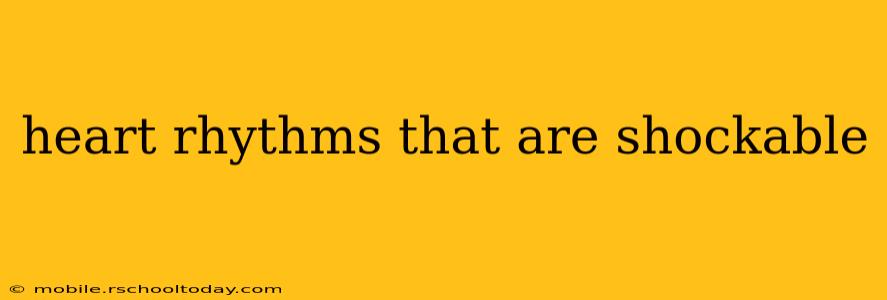Sudden cardiac arrest (SCA) is a life-threatening emergency where the heart suddenly stops beating effectively. While many heart rhythm abnormalities can cause a person to collapse, only certain rhythms are considered "shockable" – meaning they respond to defibrillation, a procedure that uses an electric shock to reset the heart's rhythm. Understanding which rhythms are shockable is crucial for effective emergency response.
What is Defibrillation?
Defibrillation is a procedure using a device called a defibrillator to deliver a high-energy electrical shock to the heart. This shock aims to interrupt the chaotic electrical activity causing the abnormal heart rhythm and allow the heart's natural pacemaker to resume a normal heartbeat. It's a life-saving intervention often performed in emergency situations by trained medical personnel or using automated external defibrillators (AEDs).
Which Heart Rhythms Are Shockable?
The primary shockable rhythms are ventricular fibrillation (VF) and pulseless ventricular tachycardia (pVT). These are life-threatening arrhythmias characterized by rapid, disorganized electrical activity in the ventricles (the lower chambers of the heart). This prevents the heart from effectively pumping blood to the body, leading to cardiac arrest.
Ventricular Fibrillation (VF)
VF is a chaotic and erratic heart rhythm. The ventricles quiver instead of contracting effectively, resulting in no pulse and no blood flow. The electrocardiogram (ECG) tracing of VF shows a disorganized, wavy pattern without discernible P waves, QRS complexes, or T waves. VF is a shockable rhythm and requires immediate defibrillation.
Pulseless Ventricular Tachycardia (pVT)
pVT is a rapid heart rhythm (usually over 100 beats per minute) originating in the ventricles. Although the ventricles are contracting, the rate is so fast that the heart cannot fill properly between beats, leading to ineffective blood flow and ultimately, no pulse. Similar to VF, pVT results in cardiac arrest. Pulseless VT is also a shockable rhythm requiring immediate defibrillation.
Heart Rhythms That Are NOT Shockable
Many other heart rhythms can cause cardiac arrest, but they do not respond to defibrillation. These include:
- Asystole (flatline): This is the complete absence of electrical activity in the heart. There's no organized rhythm, and defibrillation is ineffective.
- Pulseless electrical activity (PEA): In PEA, electrical activity is present on the ECG, but the heart isn't pumping blood effectively. Defibrillation is not indicated in PEA. Treatment focuses on addressing the underlying cause.
How to Identify Shockable Rhythms (for trained professionals):
Accurate identification of shockable rhythms requires proper ECG interpretation. Paramedics, emergency medical technicians (EMTs), and other trained medical professionals are equipped to assess heart rhythms quickly and determine the appropriate treatment. The use of AEDs provides automated analysis for lay responders, increasing the chances of successful defibrillation.
What if I Witness a Cardiac Arrest?
If you witness someone collapse and become unresponsive, immediately call emergency medical services and begin CPR. If an AED is available, follow the device's instructions. Early defibrillation within the first few minutes of cardiac arrest significantly improves survival chances.
Frequently Asked Questions
What are the chances of survival after defibrillation?
The chances of survival after defibrillation depend on several factors, including the time to defibrillation, the underlying cause of cardiac arrest, and the overall health of the individual. Early defibrillation significantly increases the likelihood of survival.
Can defibrillation be harmful?
While defibrillation is a potentially life-saving procedure, it carries a small risk of complications. These are rare and usually outweighed by the benefits of restoring a normal heartbeat.
What happens after defibrillation?
After defibrillation, the patient is closely monitored for restoration of a normal heart rhythm and pulse. Further treatment may be necessary, depending on the underlying cause of the cardiac arrest.
This information is for educational purposes only and does not constitute medical advice. Always consult with a qualified healthcare professional for any health concerns or before making any decisions related to your health or treatment.
